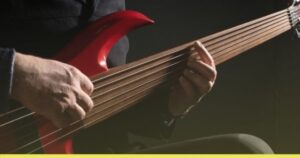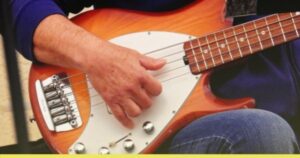Note: This guide will help you learn about the types of bass guitars even if you have no idea about bass guitars whatsoever. I have also picked the best guitar in the category according to the type of basses and shared tips on how to choose your first bass guitar.
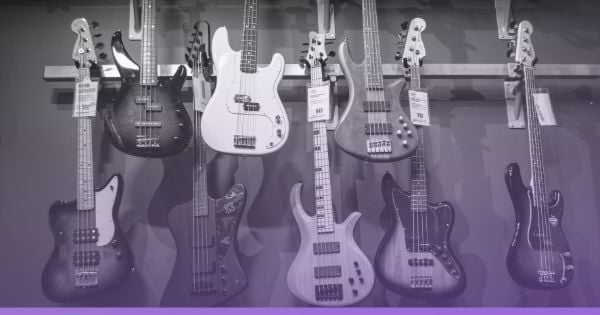
* There may be affiliate links on this page. As an Amazon Associate we earn from qualifying purchases.
The bass guitar, often known as an electric bass or just bass, is the guitar’s lowest-pitched element and there a plenty of bass guitar types. It’s a plucked string instrument with a larger neck and scale length, and commonly four to six strings or courses, comparable in look and structure to an electric or acoustic guitar.
The four-string bass is normally tuned the same as the double bass, which is one octave lower than a guitar’s four lowest-pitched strings (E, A, D, and G). It’s typically played with the fingers and thumbs, or with a pick (different kinds of bass guitars are played differently). Electric basses require extra amplification to be heard at regular performance volumes.
Quick Summary of Types of Bass Guitars
- There are 2 main categories of bass guitars: Electric & Acoustic
- Electric bass guitars need amplification to make the guitar audible
- Fretless & Upright bass guitars are usually preferred by professionals
- A 5-string bass gives you an increased range and extra notes to work with.
- If you’re looking for ease of playability you can go for kid-size or short scale bass guitars
The fingerboard of the bass is formed by the scale, which runs the length of the string. The scale length varies, but it is typically 34-35 inches long, whereas “small scale” bass guitars are typically 30-32 inches long. Short scale bass guitars are ideal for beginners and younger players as the frets are closer together and easier to play. Traditional bass guitars have a longer scale length which provides a more defined tone.
Here’re the different types of bass guitars with their uniqueness, expertise and genre to help you find the right bass guitar. I have also included helpful links to list of guitars I have compiled for the specific type of bass guitar wherever I could. So let’s get started without further ado!
Related Article: Is Bass Guitar Easy To Learn? | Bass Vs. Guitar
Here are the 7 Different Types of Bass Guitars
1. Electric Bass Guitars
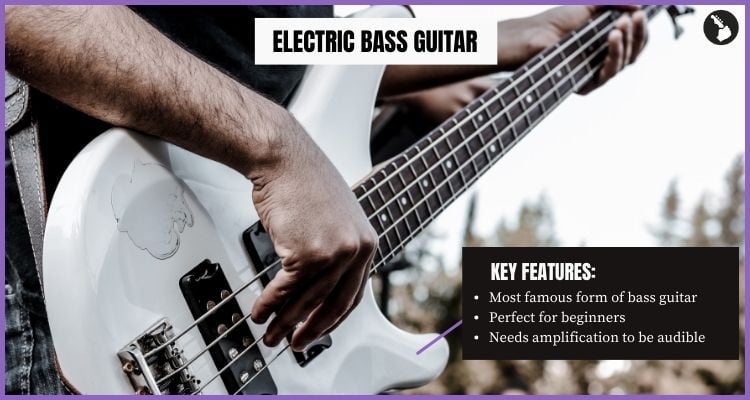
The most widely used form of bass guitar is the four-string electric bass. It’s usually the first guitar you get as a beginner to start your journey as a bassist. I would recommend a getting started with a Fender Player Precision Bass to get started with an electric bass.
What’s unique about this type?
The electric guitar is often played with a pick, which is used to strike the strings and cause them to ring out and produce sound. Bass guitars are larger and have thicker strings than electric guitars, but manufacturers also recognise the need for bass for small hands and have a range of options there too. Electric bass guitars produce a deeper low-end rumble that fills the room.
What level of expertise is required?
Electric bass guitars are fun to play and make excellent starter instruments. Even if you’ve played an acoustic or electric guitar before, learning bass guitar will be a whole new experience in which you’ll have to mould and polish your playing methods. If you’re wanting to play metal, heavy metal, or rock, five and six string guitars are excellent choices. With the additional string, you’ll be able to reach all of those lower notes without having to de-tune and re-tune your guitar.
What genre is it best for?
Electric bass guitars are commonly used in a variety of musical forms, particularly rock & roll. Its ability to generate a wide range of sounds, ranging from calm jazz to distorted hard metal. Regardless of the genre – indie, pop, metal, country, rock, and so on an electric bass guitar that sounds nice, is dependable, and is easy to play.
2. Acoustic Bass Guitar
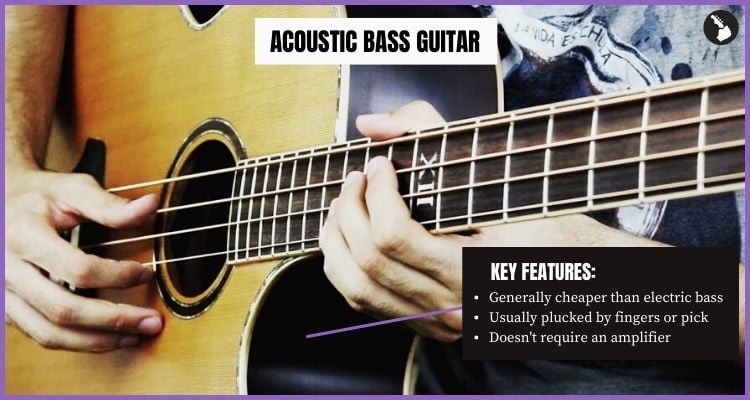
The acoustic bass guitar has four strings that are tuned an octave below a regular guitar. This guitar has an acoustic soundboard that amplifies the vibrations of the strings. Unlike electric guitars, which make sound using pickups and an amplifier, acoustic guitars make sound using only their strings and the soundboard of the guitar itself. The acoustic bass guitar is a versatile instrument that can be used solo or in a band or symphony setting. A Fender CB-60SCE is a great choice for an acoustic bass.
What’s unique about this type?
The acoustic bass guitar is again played with a pick to produce sound. The sound is generally produced through the vibrations of the soundboard. It is less expensive in comparison to the electric bass guitar and doesn’t need any power supply to play music. It has a wider body and thicker neck than electric bass guitars. The strings are composed of metal and are comparable to the strings on an electric bass guitar, except they are heavier and produce more vibrations.
What level of expertise is required?
Acoustic bass guitars do not require electricity or any additional equipment to produce sound. One can simply strum the guitar to produce deep, richer tones. However, acoustic bass guitars are a little heavier and bigger than electric bass guitars and hence, may require some practice to play. They are the best choice for people who wish to practice and sing alongside as the vibrations of the guitar alone produce a weaker sound.
What genre is it best for?
Acoustic bass guitar produces a very pleasing sound and singers of country or jazz music prefer using acoustic bass guitars as it accompanies the vocals really well.If you wish to play country, jazz or sing while playing a guitar, then acoustic is your go-to!
3. Fretless Bass Guitar
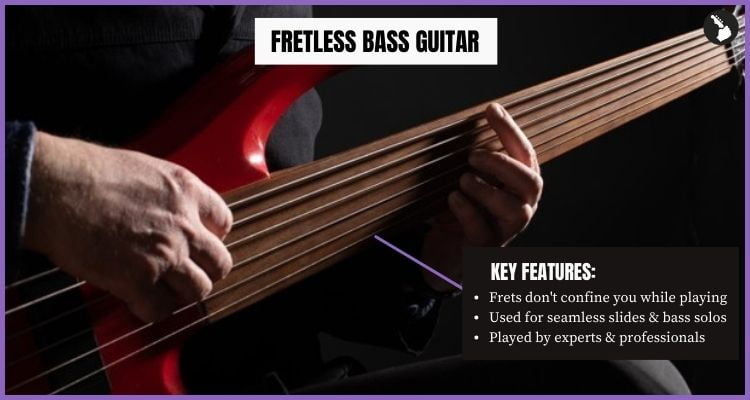
When you play a fretless bass guitar, the absence of frets is the first thing you’ll notice. It takes some getting accustomed to, but it’s not quite as complicated as it appears. A Fender Player Jazz – Fretless Pau Ferro would be my pick for some amazing fretless bass action.
What’s unique about this type?
Fretless basses have the advantage of allowing you to generate a greater spectrum of sounds. The metal wires that run up and down the bass neck beneath the strings are known as frets. When you press the string down, they serve to precisely separate the sounds on each string. You can move your fingers over the fretboard to create vibrato, slides, and other effects because there are no frets to confine you.
What level of expertise is required?
It’s a little more difficult to play fretless bass than it is to play fretted bass. You shouldn’t buy a fretless bass unless you’re certain that’s the sound you want. Playing fretless bass requires a lot of extra practise. It’s easy to sound horrible when you’re missing notes or playing sloppily. Many pupils will be annoyed by this.
What genre is it best for?
Fretless bass guitar is more suited to soloing and is most typically found in jazz, but it may also be found in soulful popular music.
4. Short Scale Bass Guitar
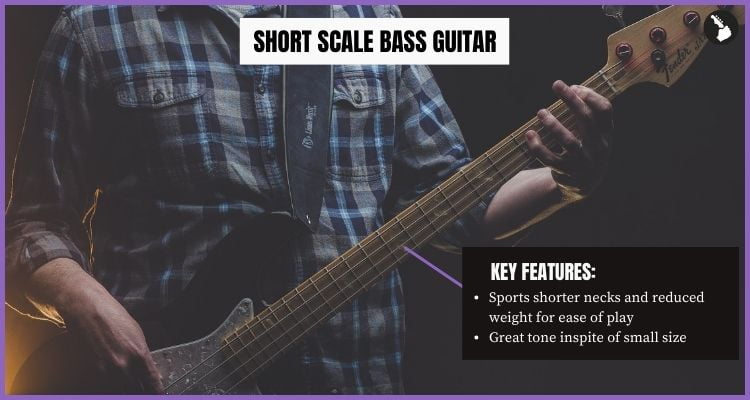
When it comes to personalising the playability of your bass guitar, you can choose from a long scale and a short scale bass guitar. In this list, we’ve included a short scale bass guitar because generally, beginner bass players prefer to go with a short scale bass. Ibanez 4 String GSRM20BS is a great short scale bass if you’re in the market for one.
What’s unique about this type?
For players of all abilities, short-scale bass guitars provide a unique playing experience. These small bass guitars are ideal for players who want the feel of a full-size bass but don’t have the space or budget to invest in one. Short-scale bass guitars provide a strong tone despite their small size. They have shorter necks and are lightweight bass guitars making them simpler to handle, while the lower string tension makes playing them more enjoyable.
What level of expertise is required?
A short-scale bass guitar is a terrific alternative for any musician searching for an economical, portable instrument, whether you’re a beginner or an experienced performer. If you’re a guitarist looking to branch out into bass, they’re ideal since their short scale gives the impression that you’re playing something halfway between a bass and a guitar, making the move easier.
What genre is it best for?
Short-scale bass guitars are popular in a wide range of musical genres, especially rock and roll. Its capacity to produce a diverse spectrum of sounds, from soothing jazz to distorted hard metal. A short scale bass guitar that sounds good, is durable, and is easy to play, regardless of the genre – indie, pop, metal, country, rock, and so on.
5. Kid-size Bass Guitar
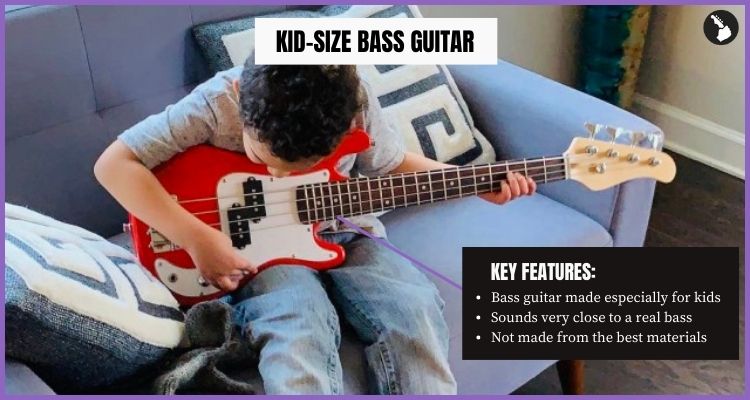
If you see a potential bass guitarist in your child then this is the bass guitar you can get to maximise the playability at age 4-12 years. Fender makes some great kid bass, Squier by Fender Mini Precision Bass being one of the bests.
What’s unique about this type?
A bass guitar is a plucked string instrument with a built-in guitar for children. There’s a hint of electric guitar in there, but the frequencies are lower. The bass guitar’s metal strings vibrate across one or more magnetic pickups, producing a calming sound (although non-magnetic pickups are occasionally used as well). The pickups then send a signal to an amplifier via instrument cable, allowing the bass to be heard at a variety of volumes.
What level of expertise is required?
As it is a kids sized bass guitar, it is suitable for a complete beginner. Any kid who can read, write and can hold a guitar is good to go!
What genre is it best for?
Kids sized bass guitar is suitable for every genre – whether it’s pop, rock & roll, jazz or even for playing their favourite nursery rhymes and songs!
6. 5-String Bass Guitar
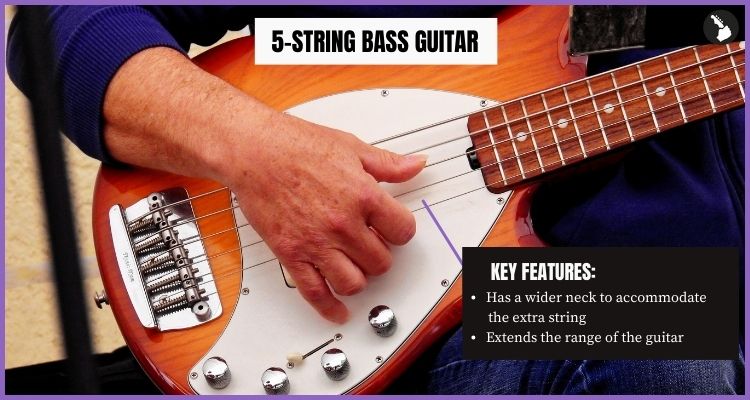
The 5-string bass guitar was developed in the 1960s as musicians sought new ways to enhance the bass tone for better performances. Squier by Fender Classic Vibe 70’s Jazz Bass V is my favourite affordable 5-string bass.
What’s unique about this type?
The 5-string has the same working characteristics as the 4-string, except it has an extra string. The guitar’s longer neck must accommodate this additional string. It basically increases the playing field on the neck of the bass to give the player more freedom for solo-ing or playing a chord.
What level of expertise is required?
In terms of practicality, it would rely on your bass playing abilities. Professionals would like to play the 5-string bass guitar because it does not require retuning with other instruments. Pros also like playing with more notes on the 5-string since it gives them greater freedom to accompany a range of musical instruments with different pitches.
What genre is it best for?
Five string bass guitars comes with an additional string that provides way more flexibility and can be easily used to play jazz, rock, metal or even heavy metal music.
7. Upright Bass Guitar

An upright bass guitar is also known as a double bass, standup bass, or contrabass. It dates back to the 15th century and it is the oldest member of the bass family on our list. A good upright bass I can suggest is Cecilio CDB Size.
What’s unique about this type?
Upright bass is an acoustic stringed instrument that can be played standing or sitting. The player either uses their fingers or a bow to pluck the strings. The largest and lowest sounding member of the string family is the stand-up bass guitar. It comes in two basic shapes: viola and violin. Other designs are available, such as a guitar design. It comes in a wide range of sizes, with the largest often measuring less than 6 feet in length.
What level of expertise is required?
The double bass is a hard instrument that needs strength, stamina, and good technique from its performer. Musical and rhythmic correctness are critical to the success of the orchestra as a whole, requiring a lot of preparation and repetition. Hence, generally a professional opts for this type of bass guitar.
What genre is it best for?
The double bass can also be played pizzicato, which is used frequently in jazz and dance bands but not always in symphonic orchestras.
The bass is an element of the rhythm section and also serves as a melody instrument in jazz bands. When played with such groups, it is frequently electronically enhanced.
How to Choose Your First Bass Guitar
Types of bass guitar strings
The string is the heart of a guitar. Without them, the guitar will no longer be useful. However, throw the strings in and the guitar will be ready to rock ‘n’ roll!
A bass guitar has four strings and comes in different varieties. They are generally differentiated based on winding and wrap. Bass strings are divided into four types based on their winding:
Flatwounds: Flatwounds were very popular back in the 1960s and were used to play jazz and vintage rock. They feel smooth on the hands while playing and are easy on the frets.
Tapewound: Tapewound strings have a nylon coating around the steel core that makes these strings feel even smoother to touch than flatwounds. They have a heavy tone to them, and a timbre more akin to an upright bass.
Roundwounds: Roundwounds are the most commonly used winding type nowadays. These strings are known for their piano-like brilliance and sizzle, and are usually covered in stainless steel or nickel. They’re also the roughest on your fingers, frets, and fretboard, but if you’re into rock or funk, they give a signature sound that’s difficult to match.
Half-round: Half rounds are just roundwounds that have been ground to a slightly flattened surface, resulting in less string noise and extending the life of your frets.is one of the popular strings among today’s generation. It is perfect for rock or funk type music. Sometimes it may feel hard on your fingertips.
Based on material or wrap:
Stainless steel: Stainless steel coating on the strings gives you a brighter sound while playing. It also ensures that the strings last for a long time.
Nickel-plated steel: Nickel-plated steel has a bright sound, yet it’s gentler on the hands and frets.
Copper-plated steel: Copper-plated string is a popular choice for acoustic electric basses since it is quite brilliant.
Pure nickel: Pure nickel has a vintage tone and is duller sounding (it’s the least magnetic material).
Parts of a bass guitar
A bass guitar has many parts from start to end. All the parts are equally important. They play a vital role to complete the instrument. The important parts of the guitar are,
Headstock: The top part of the bass guitar is known as the headstock. The knob of the guitar is placed here. From that place, the tuning of the guitar is controlled.
Neck: The part that joins the headstock with the guitar is called the neck. The freat board, frets and strings all get a place on the neck.
Body: The largest part of the guitar is the body. It is made with some solid material.
Pickups: Pickups found in the centre of the body. One can control the tone by adjusting the position of the pickup.
Bridge: this is the last portion of the guitar. It is made with strong material and attached to the body. All the strings meet the endpoint in the bridge.
How to choose the right bass for you
Choosing the perfect bass guitar for beginners is quite difficult if you are not clear about the criteria of choosing the perfect bass guitar. While choosing the bass guitar one must clear about some points those are,
Size of the guitar:
One must always remember to choose a bass guitar that they will be most comfortable while playing. So depending on your body and hand size, you should select a guitar which you will be able to hold and play properly without any discomfort.
Tune adjustment:
You should also check whether the tuning pegs on the guitar can be easily turned to tighten or loosen the guitar strings.
Condition of the guitar: Make sure that the condition of the guitar is pretty well. If you are buying an electric bass guitar then connect the guitar with an amplifier and check if its producing a full sound before buying.
Neck width:
Another important aspect is the neck of your bass guitar. A number of neck styles are available. Certain neck shapes may make it easier to travel the fretboard, depending on your preference and playing style.
Other FAQ about Bass Guitars
Do you need an amp for a bass guitar?
An amp is only necessary for an electric guitar and not for every kind of bass guitar. If you go for an acoustic guitar, external amplification is not necessary and the guitar is audible by itself. But because of technology, you can also plug in your guitar to a computer or smart phone and make it audible that way (or listen in headphones).
Related article: 9 Best Small Bass Amps for Gigging
Are all bass guitars electric?
Amps for electric bass, audio cable, tuner, bass guitar picks, straps for playing whilst standing up, and something that helps you learn and practice regularly. You can go for a guitar learning app, follow someone on YouTube or learn to play bass via tabs.
Are all bass guitars electric?
No, all bass guitars are not electric. There are acoustic styles of bass and then there are electric styles. The electric-style basses need to be plugged in to be audible while the acoustic bass can be audible without any electric connection.
In conclusion
So there you have it: a quick rundown of the various bass guitar kinds and their tones. Hopefully, this has clarified a few things for you and given you a better grasp of what to look for when making your next purchase. As always, if you have any questions or would want more information on anything we’ve discussed today, please don’t hesitate to contact us. We’re always willing to assist!

Sarah Jones
Hello! I am Sarah and I've been a bass player for as long as I remember. I picked up my first bass at age 7 and have never let go of it ever since. I've been a part of 3 bands and currently play for a band called ‘Neptune Nerds’. I love to talk about bass and share my experience with these instruments!

